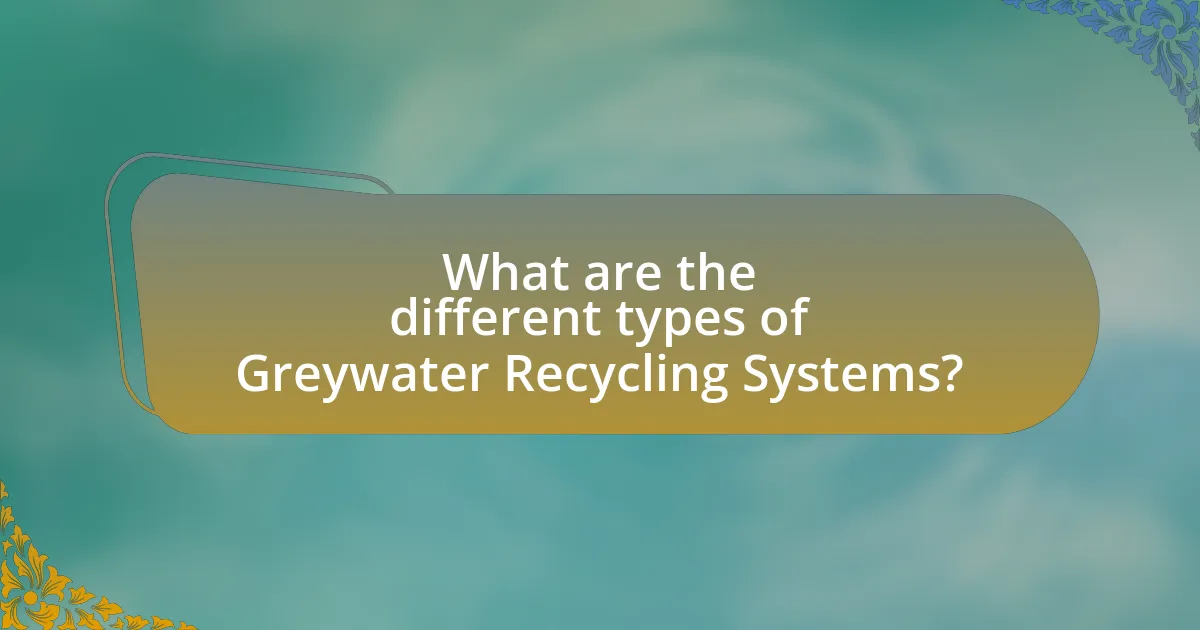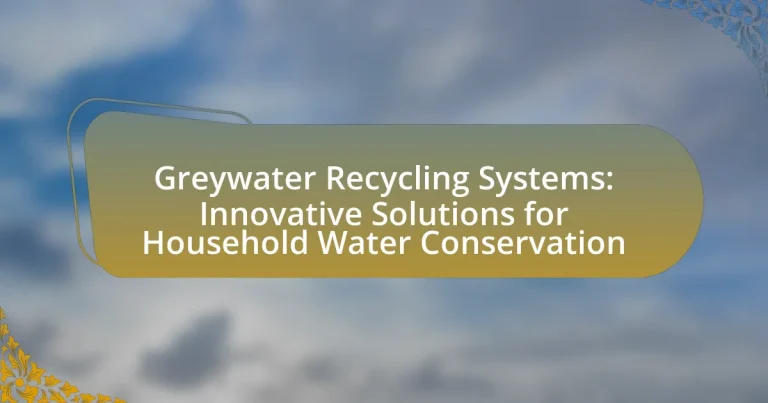Greywater recycling systems are advanced technologies that collect, treat, and reuse wastewater from household activities such as bathing, laundry, and dishwashing for non-potable applications like irrigation and toilet flushing. These systems can significantly reduce household water consumption by up to 50%, promoting water conservation and sustainability. The article explores the functioning of greywater recycling systems, the types of greywater that can be recycled, key components, and their importance in water conservation. It also addresses the challenges associated with these systems, including regulatory considerations, health and safety concerns, and maintenance requirements, while highlighting best practices for effective implementation in residential and commercial settings.

What are Greywater Recycling Systems?
Greywater recycling systems are technologies designed to collect, treat, and reuse wastewater generated from household activities such as bathing, laundry, and dishwashing. These systems typically filter and disinfect greywater to make it suitable for non-potable applications, such as irrigation and toilet flushing. According to the U.S. Environmental Protection Agency, implementing greywater recycling can reduce household water consumption by up to 50%, thereby promoting water conservation and sustainability.
How do Greywater Recycling Systems function?
Greywater recycling systems function by collecting, treating, and reusing wastewater generated from household activities such as bathing, laundry, and dishwashing. These systems typically involve a series of processes including filtration, sedimentation, and disinfection to remove contaminants and pathogens, making the water safe for non-potable uses like irrigation and toilet flushing. According to the U.S. Environmental Protection Agency, greywater can account for up to 50% of residential wastewater, highlighting the potential for significant water conservation through effective recycling systems.
What types of greywater can be recycled?
The types of greywater that can be recycled include water from sinks, showers, bathtubs, and washing machines. This greywater is typically less contaminated than blackwater, making it suitable for reuse in irrigation, toilet flushing, and other non-potable applications. According to the U.S. Environmental Protection Agency, recycling greywater can significantly reduce water consumption and promote sustainable water management practices.
What are the key components of a greywater recycling system?
The key components of a greywater recycling system include a collection tank, filtration system, storage tank, and distribution system. The collection tank gathers greywater from sources like sinks and showers, while the filtration system removes contaminants to ensure water quality. The storage tank holds the treated greywater until it is needed, and the distribution system delivers the recycled water for irrigation or toilet flushing. These components work together to efficiently recycle water, reducing overall household water consumption and promoting sustainability.
Why are Greywater Recycling Systems important for water conservation?
Greywater recycling systems are important for water conservation because they allow the reuse of wastewater from sinks, showers, and washing machines for non-potable purposes, significantly reducing overall water consumption. By recycling greywater, households can decrease their reliance on freshwater sources, which is crucial in areas facing water scarcity. Studies indicate that greywater recycling can reduce water usage by up to 50%, thereby alleviating pressure on municipal water supplies and promoting sustainable water management practices.
How do these systems contribute to reducing water waste?
Greywater recycling systems significantly reduce water waste by reusing water from sinks, showers, and laundry for irrigation and toilet flushing. These systems can reclaim up to 50-80% of household wastewater, which would otherwise be discharged into sewage systems. For instance, a study by the Water Research Foundation found that implementing greywater systems can lead to a reduction of potable water use by approximately 30%. This not only conserves water resources but also decreases the energy required for water treatment and distribution, further enhancing sustainability.
What environmental benefits do Greywater Recycling Systems provide?
Greywater Recycling Systems provide significant environmental benefits by reducing freshwater consumption and minimizing wastewater discharge. These systems recycle water from sources like sinks, showers, and washing machines, which can be reused for irrigation and toilet flushing. By utilizing greywater, households can decrease their overall water usage by up to 50%, as reported by the U.S. Environmental Protection Agency. This reduction in demand for potable water helps conserve natural water resources and lowers the energy required for water treatment and distribution, thereby decreasing greenhouse gas emissions associated with these processes. Additionally, greywater recycling can alleviate pressure on sewage systems, reducing the risk of overflow and pollution in local waterways.

What are the different types of Greywater Recycling Systems?
The different types of greywater recycling systems include direct reuse systems, treatment systems, and hybrid systems. Direct reuse systems allow for the immediate use of greywater from sources like sinks and showers for irrigation or toilet flushing without extensive treatment. Treatment systems, such as biological or membrane filtration, process greywater to remove contaminants, making it safe for non-potable uses. Hybrid systems combine elements of both direct reuse and treatment, offering flexibility in how greywater is managed and utilized. These classifications are essential for understanding how greywater can be effectively recycled in households, contributing to water conservation efforts.
How do passive and active systems differ?
Passive systems rely on natural processes and gravity to collect and treat greywater, while active systems use mechanical components and energy to facilitate the collection, treatment, and distribution of greywater. For example, passive systems may involve simple filtration methods and gravity-fed drainage, whereas active systems often include pumps, sensors, and advanced filtration technologies to enhance efficiency and control. This distinction is crucial in greywater recycling, as passive systems typically require less maintenance and energy, while active systems can provide more reliable and higher-quality water for reuse.
What are the advantages of passive greywater systems?
Passive greywater systems offer several advantages, including low maintenance requirements, cost-effectiveness, and environmental benefits. These systems utilize gravity to direct greywater from sinks, showers, and laundry to irrigation areas without the need for pumps or complex machinery, which reduces operational costs. Additionally, they promote water conservation by recycling water for landscape irrigation, thus decreasing the demand for potable water. Studies indicate that passive greywater systems can significantly reduce household water usage by up to 50%, contributing to sustainable water management practices.
What features define active greywater recycling systems?
Active greywater recycling systems are characterized by their ability to treat and reuse wastewater from household sources such as sinks, showers, and washing machines. These systems typically include features like filtration, biological treatment, and disinfection processes to ensure the water is safe for non-potable uses, such as irrigation or toilet flushing. For instance, many active systems utilize mechanical components like pumps and sensors to automate the collection and treatment process, enhancing efficiency and reliability. Additionally, they often incorporate storage tanks to hold treated greywater until needed, which allows for flexible usage based on demand. The effectiveness of these systems is supported by studies indicating that they can significantly reduce household water consumption, thereby contributing to water conservation efforts.
What are the most common applications of Greywater Recycling Systems?
The most common applications of Greywater Recycling Systems include irrigation, toilet flushing, and laundry. These systems effectively reuse water from sinks, showers, and washing machines, reducing overall water consumption. For instance, studies indicate that approximately 50-80% of household wastewater can be recycled for these purposes, significantly conserving potable water resources. In irrigation, greywater can provide essential moisture for gardens and landscapes, while using it for toilet flushing can save thousands of gallons of drinking water annually.
How are these systems used in residential settings?
Greywater recycling systems are used in residential settings to reclaim and reuse water from sources such as sinks, showers, and washing machines for non-potable applications like irrigation and toilet flushing. These systems help reduce overall water consumption, with studies indicating that they can save up to 50% of household water usage. By filtering and treating greywater, these systems provide an eco-friendly solution that not only conserves water but also decreases the demand on municipal water supplies and reduces wastewater generation.
What role do Greywater Recycling Systems play in commercial buildings?
Greywater Recycling Systems in commercial buildings serve the critical role of reducing water consumption and promoting sustainability. These systems collect and treat wastewater from sources such as sinks, showers, and laundry, allowing it to be reused for non-potable applications like irrigation and toilet flushing. According to the U.S. Environmental Protection Agency, implementing greywater recycling can reduce overall water usage by up to 50%, significantly lowering operational costs and environmental impact.

What challenges are associated with Greywater Recycling Systems?
Greywater recycling systems face several challenges, including contamination risks, regulatory hurdles, and maintenance requirements. Contamination can occur if greywater is improperly treated, leading to health risks from pathogens and chemicals. Regulatory hurdles often arise due to varying local laws that may restrict the use of greywater or impose strict guidelines on treatment processes. Additionally, these systems require regular maintenance to ensure effective operation, which can be costly and labor-intensive. According to a study published in the Journal of Environmental Management, improper maintenance can lead to system failures, further complicating the implementation of greywater recycling in households.
What regulatory considerations must be addressed?
Regulatory considerations for greywater recycling systems include compliance with local health and safety codes, water quality standards, and installation permits. Local health departments often regulate the treatment and reuse of greywater to prevent contamination of potable water supplies. For instance, the U.S. Environmental Protection Agency (EPA) provides guidelines that many states adopt, which outline acceptable practices for greywater use, including treatment methods and system maintenance. Additionally, obtaining the necessary permits ensures that the system meets local building codes and environmental regulations, which vary by jurisdiction.
How do local laws impact the installation of greywater systems?
Local laws significantly impact the installation of greywater systems by establishing regulations that dictate their design, usage, and maintenance. These laws often require permits, specify acceptable greywater sources, and outline safety standards to prevent contamination. For instance, in California, the Department of Water Resources has implemented guidelines that allow the use of greywater for irrigation, provided that systems meet specific criteria to protect public health and the environment. Compliance with these regulations ensures that installations are safe and effective, influencing the overall adoption and implementation of greywater recycling systems in various regions.
What health and safety concerns should be considered?
Health and safety concerns related to greywater recycling systems include the potential for pathogen transmission, chemical contamination, and improper system maintenance. Pathogen transmission can occur if greywater contains harmful microorganisms from human waste, which can pose health risks if not adequately treated. Chemical contamination is a concern when greywater includes residues from household cleaners, detergents, or personal care products, which may be harmful to human health and the environment. Additionally, improper maintenance of greywater systems can lead to system failures, creating unsanitary conditions and potential hazards. According to the U.S. Environmental Protection Agency, proper treatment and maintenance protocols are essential to mitigate these risks and ensure safe use of recycled greywater.
What maintenance is required for Greywater Recycling Systems?
Greywater recycling systems require regular maintenance to ensure optimal performance and hygiene. This maintenance includes routine inspections of filters and pumps, which should be cleaned or replaced as necessary to prevent clogs and ensure efficient operation. Additionally, the system’s storage tanks must be checked for signs of algae growth or sediment buildup, which can compromise water quality. Regular testing of the recycled water for contaminants is also essential to ensure safety and compliance with health regulations. According to the U.S. Environmental Protection Agency, maintaining these systems can significantly enhance their longevity and effectiveness in conserving water.
How often should greywater systems be inspected?
Greywater systems should be inspected at least once a year. Regular inspections help identify potential issues such as clogs, leaks, or system malfunctions that could affect performance and safety. According to the U.S. Environmental Protection Agency, annual inspections are recommended to ensure compliance with local regulations and to maintain system efficiency.
What common issues might arise and how can they be resolved?
Common issues that might arise with greywater recycling systems include contamination, system clogging, and improper installation. Contamination can occur if harmful substances enter the greywater, leading to health risks; this can be resolved by implementing strict guidelines for what can be included in the greywater system, such as avoiding the use of certain chemicals in cleaning products. System clogging often results from the accumulation of debris and organic matter; regular maintenance and the use of pre-filters can mitigate this issue. Improper installation can lead to inefficiencies and system failures; hiring certified professionals for installation ensures compliance with local regulations and optimal system performance.
What are best practices for implementing Greywater Recycling Systems?
Best practices for implementing greywater recycling systems include conducting a thorough assessment of local regulations, selecting appropriate treatment technologies, and ensuring proper system design and installation. Local regulations often dictate the types of greywater that can be reused and the necessary permits, making compliance essential for legal operation. Choosing treatment technologies, such as filtration and disinfection methods, is crucial for ensuring water quality and safety, as untreated greywater can pose health risks. Additionally, proper system design should consider factors like water source, intended use, and maintenance requirements to optimize efficiency and longevity. These practices are supported by studies indicating that well-designed greywater systems can reduce household water consumption by up to 50%, demonstrating their effectiveness in water conservation efforts.
How can homeowners effectively integrate these systems into their properties?
Homeowners can effectively integrate greywater recycling systems into their properties by first assessing their plumbing layout to identify suitable sources of greywater, such as sinks, showers, and washing machines. This assessment allows for the strategic installation of a greywater collection system that directs used water to a treatment unit, which can filter and purify the water for reuse in irrigation or toilet flushing.
Additionally, homeowners should ensure compliance with local regulations regarding greywater use, as many jurisdictions have specific guidelines that govern the installation and operation of these systems. For instance, the California Department of Water Resources provides detailed regulations and best practices for greywater systems, emphasizing the importance of proper filtration and maintenance to ensure safety and efficiency.
By following these steps, homeowners can successfully integrate greywater recycling systems, contributing to water conservation efforts while also reducing their utility bills.
What tips can ensure optimal performance of greywater systems?
To ensure optimal performance of greywater systems, regular maintenance is essential. This includes routine inspections to check for clogs, leaks, and proper functioning of pumps and filters. Additionally, using biodegradable soaps and detergents minimizes harmful chemicals in the greywater, promoting better treatment and reuse. Research indicates that systems designed with appropriate filtration and treatment processes can effectively reduce pathogens and contaminants, enhancing water quality for irrigation and other non-potable uses. Implementing these practices can significantly improve the efficiency and longevity of greywater systems.


